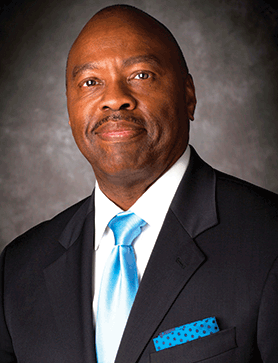2016 CEOs Who 'Get It'
The National Safety Council recognizes seven leaders who demonstrate a personal commitment to worker safety and health

 |
Phil Washington
CEO
Los Angeles County Metropolitan Transportation Authority
Los Angeles, CA
 |
Accomplishments
The LOS ANGELES COUNTY METROPOLITAN TRANSPORTATION AUTHORITY operates the third largest public transportation system in the United States by ridership with a 1,433-square-mile operating area and 2,000 peak-hour buses on the street on any given business day. LA Metro employs more than 10,000 workers. |
Why is safety a core value at your organization?
When I first arrived at Metro, I circulated my vision statement throughout the organization and stated clearly that safety and security are our No. 1 priority. Part of that is remembering that we are in the service business and that all our customers deserve a safe environment. To that end, Metro has added new technologies and methods to keep our passengers and employees safe. We moved aggressively to install steel and polycarbonate barriers on our new buses to protect operators from assault. We are also committed to installing CCTV monitors on our buses that allow the passenger to see themselves boarding and then seated in the bus. The concept is that if a person sees themselves on a monitor, he or she knows that there is video recording and he or she is less likely to commit a crime. Metro used State of California grants to provide extra security at many of our high-volume parking lots by deploying the SkyWatch Tower that elevates to 24 feet and provides a video or personal platform for surveillance. Keeping commuters’ cars safe in Metro parking lots is part of providing an excellent transit experience. Metro is also an industry leader in cracking down on sexual harassment on the bus and rail system. Our campaign called “It’s Off Limits” was successful in reducing reported incidents of sexual harassment from 22 percent to 19 percent between December 2014 and May 2015.
Describe your personal journey to becoming a leader who “gets it.” What experiences or lessons brought you to where you are now?
My journey began with my childhood growing up in public housing in the South Side of Chicago. I found direction and a career with the United States Army and rose to the level of Command Sergeant Major before retiring from active duty to join the Regional Transportation District in Denver. I believe in focusing on the basics such as curbs, sidewalks and first/last mile, even as Metro is embarking on one of the largest public works building efforts in the world.
What is the biggest obstacle to safety at your organization, and how do you work to overcome it?
Safety is a result of a culture, and I was lucky enough to join an organization that already had a strong culture of safety. In any organization, all components are interconnected and are designed to work together to accomplish the goal of providing excellence in service and support. Communication between departments is important to achieving that goal, so we stress the importance of breaking down silos. I also want to say that partnership with our union leadership is instrumental in maintaining a culture of safety.
How do you instill a sense of safety in employees on an ongoing basis?
Training is important. Metro is pilot testing a program called Transit Ambassador, which is a customer service program that also contains elements to help our operators deal with stress on the job and at home. Also, it helps operators deal with potentially dangerous situations in the field. Additionally, since May 2015, we have been using the National Safety Council Defensive Driving Course Attitudinal Dynamics of Driving program based on Choice Theory for operators. If an operator fails to stop for red lights, they must attend a nine-hour class. Since May we have trained 274 operators and only five have a repeated violation. Our success rate is 98.7 percent to date.
How does your organization measure safety?
Metro measures employee safety by evaluating both leading and lagging indicators. Some of the leading indicators that we review are unsafe behaviors, agency rules and policy violations, near-miss incidents, and reported workplace hazards. We also benchmark our design standards and practices against our peers and regulatory requirements to proactively identify and eliminate – to the greatest extent practicable – potential risks.
In many cases, we exceed the minimum standards rather than simply meeting them. Metro also reviews lagging indicators such as incidents, injuries and claims data that provide valuable information that is used to improve safety performance. Areas that we are currently working on improving are related to enhanced training for our employees, improving our maintenance practices, increasing our capital investment to maintain our existing assets in a state of good repair and enhancing our capabilities in the area of emergency management.
What role does off-the-job safety play in your organization’s overall safety program? What types of off-the-job safety and health programs does your organization offer to employees?
Metro continually strives to stress the importance of being safe – not only on the job but also at home – with the realization that such a philosophy promotes a healthy safety culture. For example, Metro’s training programs such as CPR/AED, first aid, emergency preparedness, and Metro’s labor-supported wellness programs benefit employees at work and at home. These programs, along with periodic health fairs that are conducted at various Metro facilities, are designed to educate employees about the importance of living a healthy lifestyle, nutrition and strategies to improve their overall health.
Post a comment to this article
Safety+Health welcomes comments that promote respectful dialogue. Please stay on topic. Comments that contain personal attacks, profanity or abusive language – or those aggressively promoting products or services – will be removed. We reserve the right to determine which comments violate our comment policy. (Anonymous comments are welcome; merely skip the “name” field in the comment box. An email address is required but will not be included with your comment.)

